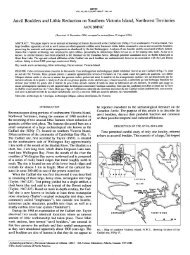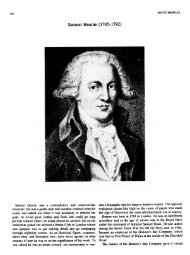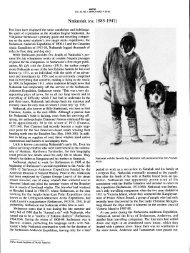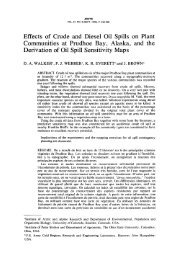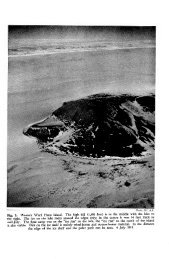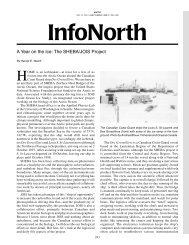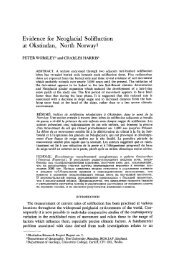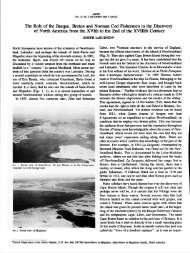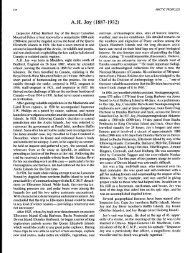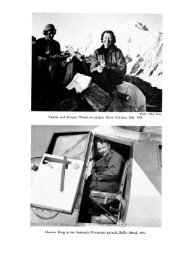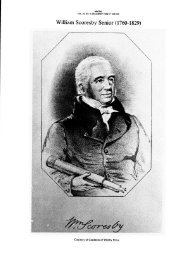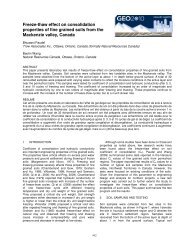May 1951 Northern News
May 1951 Northern News
May 1951 Northern News
You also want an ePaper? Increase the reach of your titles
YUMPU automatically turns print PDFs into web optimized ePapers that Google loves.
a vital part in Snow Cornice in 1948,<br />
1949, and early 1950, and was also used<br />
on the Baffin Island Expedition led by<br />
Mr. P. D. Baird last year, will again be<br />
flown by Mr. Maurice King. The surface<br />
of the Malaspina Glacier is not suitable<br />
for landings by winged aircraft and <strong>1951</strong><br />
operations below the firn line will be<br />
supported, and equipment and personnel<br />
carried to the area of study, by helicopter.<br />
A helicopter has been secured<br />
for the project by contract with the<br />
Lewis College of Science and Technology<br />
of Lockport, Illinois.<br />
Twenty-three scientific investigators<br />
and their assistants, representing California<br />
Institute of Technology, the University<br />
of Minnesota, the US. Geological<br />
Survey, Toronto University, Haverford<br />
College, the American Alpine Club, and<br />
the Institute, will take part in the <strong>1951</strong><br />
project. Field work will begin in June<br />
and the project will be terminated for<br />
this year on September 1.<br />
Gifts and contributions to<br />
expedition expenses<br />
The Chairman and Board of Governors<br />
most gratefully acknowledge the fol-<br />
lowing gifts to the Library and Museum<br />
NORTHERN NEWS 69<br />
NORTHERN NEWS<br />
McGill University Geography<br />
Summer School<br />
The following courses of special interest<br />
to students of the Arctic will be<br />
given at the McGill University Geography<br />
Summer School to be held at<br />
Stanstead College, Que., from July 2 to<br />
August 11. The arctic program will be<br />
directed by Mr. P. D. Baird, Director<br />
of the Montreal Office of the Arctic<br />
Institute.<br />
Physical Geography of the Arctic. Lecturers:<br />
P. D. Baird, F. K. Hare, and Sir<br />
Hubert Wilkins.<br />
Extent of the Arctic. The main physi-<br />
and contributions to expedition expen-<br />
ses:<br />
Gifts to the Library and Museum<br />
Books-Mrs. John W. Bell, Montreal;<br />
H. L. Eberts, Montreal; Major A.<br />
Taylor, Ottawa.<br />
Maps-Hyacinth Lambart, Montreal.<br />
.Meteorological kite from Amundsen’s<br />
Maud expedition-Department of Geo-<br />
logy and Geography, University of<br />
British Columbia.<br />
Propellor from first aircraft to fly in<br />
Hudson Strait-Baffin Island region,<br />
1927-Charles Garnett, Edmonton.<br />
Contributions to the Bafiin Island project<br />
M. H. W. Ritchie, Texas $2,500.00<br />
A. H. Campbell, Montreal 100.00<br />
J. W. A. Hickson, Montreal 100.00<br />
G. C. McDonald, Montreal 100.00<br />
Contributions to the “Blue Dolphin” project<br />
Arthur Dean, New York $1,000.00<br />
David Nutt, Ema, N.H. 1,000.00<br />
L. H. Stubbs, Portland, Me.<br />
John J. Teal<br />
600.00<br />
Carnegie Corporation $5,000.00<br />
cal features: climate, water bodies,<br />
ecology, snow and ice phenomena,<br />
landforms and terrestrial magnetism.<br />
Physical factors affecting human<br />
activity; living conditions; permafrost<br />
engineering; navigation; access by air.<br />
Main regional divisions of the Arctic.<br />
Cultural and Political Geography of the<br />
Arctic. Lecturers: P. D. Baird, Sir Hubert<br />
Wilkins, et al.<br />
Geographical regions and their characteristics.<br />
Exploration and discovery.<br />
National sovereignty and territorial<br />
claims. Native peoples, their origin,<br />
distribution, and activities. Economic
70 NORTHERN NEWS<br />
geography, including trading and<br />
transportation. Strategic considerations.<br />
Regional description.<br />
Climatology. Lecturer: F. K. Hare.<br />
Physical, dynamical, and ecological<br />
climatology, with special reference to<br />
the cool climates. Special emphasis<br />
will be laid upon (i) climatic classification;<br />
(ii) climate and vegetation,<br />
and (iii) climate and sea ice.<br />
The Soviet Union. Lecturer: Bogdan<br />
Zaborski.<br />
Territorial development of Tsarist<br />
Russia and of the U.S.S.R. Physical<br />
regions. Distribution of population,<br />
languages, and ethnic groups. Soviet<br />
agriculture and industry. Wartime and<br />
postwar changes in national economy.<br />
Tuition for the six weeks’ course..$ 90.00<br />
Board-residence for the six weeks 110.00<br />
Further information concerning the<br />
School may be obtained from Professor<br />
F. K. Hare, Director Geography Sum-<br />
mer School, McGill University, Mon-<br />
treal, Que., Canada.<br />
The magnetite occurrence at<br />
Griinnedal in Arsuk Fjord,<br />
southwest Greenland<br />
In the August 1950 number of Arctic<br />
(Vol. 3, No. 2) Dr. Richard Bpgvad<br />
described the magnetic iron ore deposit<br />
at Grpnnedal in southwest Greenland<br />
and mentioned that diamond drilling to<br />
establish the extent and content of the<br />
deposit would begin in the summer of<br />
1950. We have now received the fol-<br />
lowing note from Dr. Bagvad:<br />
In the spring of 1950 the Cryolite Mine<br />
repaired roads and houses at Grannedal<br />
after the havoc of the winter storms and<br />
the following thaw. The equipment was<br />
then transported from the coast up the<br />
mountain slopes to the magnetite occur-<br />
rence, in which work the US. Naval<br />
Base rendered much assistance.<br />
The Cryolite Company had engaged<br />
Svenska Diamantbergborrnings A/B to<br />
carry out a diamond drilling program<br />
proposed by the present writer, and<br />
work was started at the end of June.<br />
In the course of the summer six bore-<br />
holes, totalling 750 metres in depth, were<br />
made at the most promising part of the<br />
magnetite occurrence.<br />
The cores revealed that the deposit<br />
was smaller and of an inferior quality<br />
than had been expected from previous<br />
investigations. The geologists in the field<br />
estimated that up to a depth of 100<br />
metres the tonnage of ore present would<br />
amount to about I million tons of ore<br />
only and that to obtain this it would be<br />
necessary to blast a corresponding quantity<br />
of country rock.<br />
When the core samples had been<br />
analysed for iron, phosphorus, and sulphur,<br />
all results of the investigations<br />
were given to two Swedish mining experts,<br />
who independently arrived at<br />
nearly the same conclusion: up to 50<br />
metres in depth 800,000 tons of ore containing<br />
25-30 per cent of iron had been<br />
found. They considered that mining the<br />
deposit would not be an economic proposition<br />
and that further prospecting<br />
could not be justified.<br />
In accordance with these views the<br />
technical investigations of the iron ore<br />
deposit at Grlbnnedal have been terminated<br />
and all that now remains is to<br />
complete the scientific study of the rocks<br />
belonging to this unique geological formation<br />
which includes nepheline syenite,<br />
diabase, and essexite together with magnetite,<br />
hematite, siderite, and calcite.<br />
The 1950 Eastern Arctic Patroll<br />
The 1950 Canadian Eastern Arctic<br />
Patrol, the twenty-eighth since the Patrol<br />
was inaugurated, marked the maiden<br />
voyage of the C. D. Howe, the new<br />
3,600-ton Department of Transport<br />
vessel.2<br />
The C. D. Howe sailed from Montreal<br />
on July 17 with Captain A. Chouinard<br />
in command, and returned to Quebec<br />
on September 22. The vessel called at<br />
Cape Harrison, Port Burwell, Fort<br />
Chimo, Churchill, Cape Dorset, Lake<br />
Harbour, Pangnirtung, Clyde, Pond<br />
1Reprinted in the main from the Arctic<br />
Circular, Vol. 3, No. 6 (1950) p. 70.<br />
2For descriptions of this vessel see Arctic,<br />
Vol. 1, No. 2 (1948) p. 121 and Vol. 2, No.<br />
3 (1949) p. 200.
NORTHERN NEWS 71<br />
Inlet, Arctic Bay, and Dundas Harbour, At each port of call the senior medical<br />
the most northerly place reached, and<br />
at Frobisher Bay on the way back to<br />
Quebec. Using the helicopter members<br />
of the Patrol also visited Makkovik from<br />
Cape Harrison, Labrador, and George<br />
River while the ship was in Ungava Bay.<br />
Unfortunately the helicopter was lost<br />
off Fort Chimo on August 5, causing<br />
the death of Sam Ford, official Eskimo<br />
interpreter on the Patrol. Craig Harbour<br />
was not reached this year owing to lack<br />
of time. It had been planned that the<br />
R.C.M.P. detachment at Dundas Harbour<br />
was to be taken north to reopen<br />
the post at Craig Harbour, but this move<br />
had to be postponed.<br />
Fort Chimo has not usually been<br />
visited on the Patrol, but this year<br />
freight was brought in for the weather<br />
and ionospheric stations. The freight<br />
for Port Harrison, Cape Smith, and Sugluk,<br />
normally carried by the Patrol, was<br />
handled by the Hudson’s Bay Company’s<br />
ship Rupertsland and the Roman Catholic<br />
Mission ship Regina Polaris, both of<br />
which were in the Bay during the<br />
summer.<br />
In recent years the scope of the Patrol<br />
has been enlarged as a result of the<br />
increased activity in the north. It is now<br />
a combined effort of six government<br />
departments: Resources and Development,<br />
National Health and Welfare,<br />
Transport, Mines and Technical Surveys,<br />
Justice, and Post Office.<br />
The Officer in Charge of this year’s<br />
Patrol was Mr. A. Stevenson of the<br />
Arctic Division, Department of Resources<br />
and Development. He was assistofficer,<br />
Dr. J. C. Osborne of Edmonton,<br />
examined the Eskimo. Dr. Osborne was<br />
assisted by F/L J. R. Wynne and Nursing<br />
Sister M. P. Brown of the R.C.A.F.<br />
who joined the ship at Churchill. The<br />
general standard of health of the Eskimo<br />
appeared to be good and over a thousand<br />
were X-rayed. Eighteen sick Eskimo,<br />
mostly suffering from tuberculosis, were<br />
moved to Pangnirtung Hospital or outside<br />
hospitals for further medical treatment.<br />
Dr. R. S. Robertson, a dentist<br />
from Cobourg, Ontario, was kept busy<br />
checking, extracting, and filling the teeth<br />
of both whites and Eskimo.<br />
Mr. R. A. Hadden of Ottawa, was in<br />
charge of postal service. He noted a<br />
marked increase in the use being made<br />
of the mails by the Eskimo, who communicate<br />
with each other’ by syllabic<br />
script which nearly all can read and<br />
write.<br />
Among the passengers picked up or<br />
dropped along the route were the Right<br />
Reverend D. B. Marsh, Anglican Bishop<br />
of the Arctic, several Oblate missionaries,<br />
.Mr. J. W. Anderson and other<br />
officials of the Hudson’s Bay Company,<br />
Inspector Henry Larsen and Staff Sergeant<br />
W. C. Dodsworth of the R.C.M.P.,<br />
and Dr. J. H. Nesbitt. At Clyde fourteen<br />
members of hlr. P. D. Baird’s expedition<br />
were taken on board, after having spent<br />
three and a half months in the Clyde<br />
area.<br />
Weather conditions were exceptionally<br />
good and only loose ice was encountered<br />
in Lancaster Strait and Admiralty Inlet.<br />
A. STEVENSON<br />
ed by Mr. R. G. Johnston of the same<br />
Department whose duties were chiefly<br />
statistical in connection with family<br />
allowances, relief, decennial census, vital<br />
statistics, and old age allowances for the<br />
Eskimo.<br />
Members of the Patrol organized plans<br />
for taking the <strong>1951</strong> decennial census in<br />
the Arctic. Making accurate returns for<br />
Auroral observations in the<br />
Barents Sea, 1949<br />
According to a report published in<br />
Polarforschung (Bd. 2, Heft. 1/2 (1950)<br />
p. 285-6), Dr. Werner Sandner accompanied<br />
the fishing vessel Berlin of<br />
Hochseefischerei-Gesellschaft “Nordsee”<br />
(Bremerhaven) on a cruise to the Barents<br />
Sea in November and December 1949.<br />
the 8,000-odd Eskimo scattered over the His object was to study northern lights<br />
Arctic will be one of the most difficult and haloes in that area.<br />
census assignments in Canada. It will be The Berlin left Bremerhaven on Nocarried<br />
out by the R.C.M.P. and must<br />
be completed by shiptime next summer.<br />
vember 18, was off Nordkapp (North<br />
Cape) on November 23, and on reach-
72 NORTHERN NEWS<br />
ing the Barents Sea cruised in the area<br />
round lat. 71"N., long. 41"E. The homeward<br />
voyage began early in December:<br />
Nordkapp was passed on the 4th and<br />
Bremerhaven reached on the 11th.<br />
The weather was favourable and<br />
northern lights were seen on November<br />
21, 22, 24, 26, 28, and 29, and again on<br />
December 6. Few haloes occurred because<br />
the sun was already below the<br />
horizon and the moon was not full until<br />
BARTLETT MEMORIAL FUND<br />
To the Editor:<br />
The Explorers Club is inviting con-<br />
tributions to a fund in memory of Cap-<br />
tain Robert A. Bartlett whose name for<br />
so long has been associated with Arctic<br />
exploration.<br />
In view of the many years that Cap-<br />
tain Bob devoted to schooling young<br />
men in the lore of the Arctic and stimu-<br />
lating their interest in exploration in<br />
the North, it seemed fitting to establish<br />
a Robert A. Bartlett Scholarship at the<br />
Memorial University College in St.<br />
John's, Newfoundland, so near to Brigus.<br />
It is hoped that all friends of Captain<br />
CORRESPONDENCE<br />
ELECTION OF FELLOWS<br />
December 5, when the Berlin was home-<br />
ward-bound. However, lunar haloes were<br />
observed on December 6-7, from 15.00<br />
to 08.00 hr., in about lat. 70°N., and<br />
again on December 11, from 06.00 to<br />
08.00 hr., at Bremerhaven. A solar halo<br />
occurred on December 10, from 11.00 to<br />
13.00 hr., when the vessel was passing<br />
through the North Sea.<br />
Wind and temperature measurements<br />
were recorded throughout the voyage.<br />
Bob and others interested in exploration<br />
will contribute to this project. Cheques<br />
should be made payable to The Explorers<br />
Club, earmarked for the Bartlett Memorial<br />
Fund, and mailed to 10 West 72nd<br />
Street, New York City. We have been<br />
advised that United States citizens may<br />
deduct such contributions from their<br />
income tax.<br />
Very truly yours,<br />
Bartlett Memorial Fund Committee<br />
William K. Carpenter, Chairman<br />
Amos Burg<br />
John H. Foster<br />
E. Irving Huntington<br />
Alexander Wetmore<br />
At the meeting of the Executive Corn- Dr. G. Malcolm Brown, Kingston Genmittee<br />
held in Washington on 19 De- eral Hospital, Kingston, Ont., Canada.<br />
cember 1950 the following were elected Dr. S. Richard E. Bpgvad, Grqndalsvej<br />
Fellows of the Institute:<br />
Dr. C. Earl Albrecht, Department of<br />
42, Copenhagen, Denmark.<br />
Joseph T. Flakne, 3039 Macomb Street,<br />
Health, Juneau, Alaska. Washington, D.C., USA.



